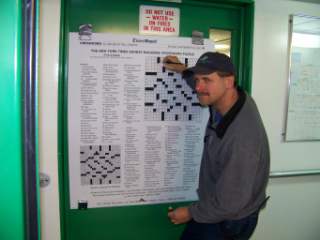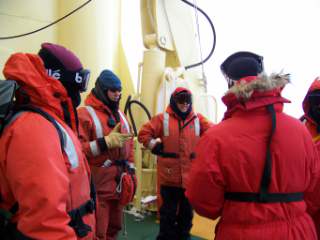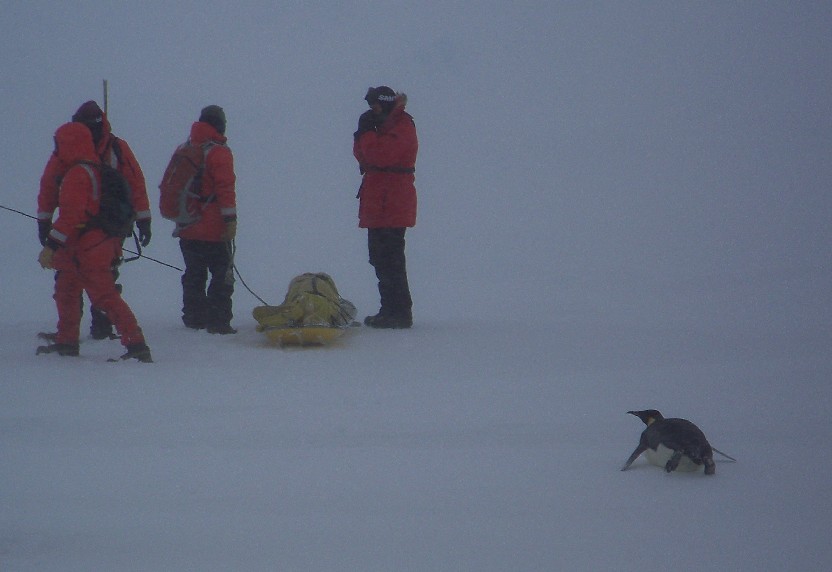Location: Drifting in the pack ice in the Bellingshausen Sea.
Latitude: 70° 26¢ S Longitude: 93° 54¢ W Air temperature: **- 11.4 °C (11.5 °F) **Wind chill temperature: - 35.4 °C (- 32 °F) Wind speed: 25 to 30 knots (29 to 35 mph) Relative humidity: 75.4 % Barometric pressure: 955 mBar
Antarctic trivia (answer at the end of this journal entry): Which gets less precipitation, the interior of the Antarctic continent or the Sahara desert?
Sunday mornings at home for me usually begin with a cup of coffee and the morning paper. I’m still an advocate of the paper version of the news, especially on Sunday, though people tell me that print journalism is on its way out due to twenty-four hour cable news and the Internet. My only problem with getting news the old-fashioned way is that one of my cats is usually sitting on the section that I want to read. I’ve gotten pretty good at doing the classic inertia demo with a cat and a newspaper – pull the paper out quickly enough and the cat’s inertia prevents him from being disturbed. Some of my cats seem to have a lot more inertia than others, but that’s a story for another day…
We were still waiting for the weather to clear this morning, so I went downstairs for coffee and settled at the desk in my room to read the paper the "new-fashioned” way – online. No paper boys venture this far south, so our news comes by email…we get The Times Digest, an 8 page version of the New York Times along with assorted wire service stories. It’s nice to hear news of the world, but it’s just not the same. I miss propping my feet on the table, sipping coffee, and thinking about, well, not too much of anything on Sunday morning. Reading the news on the computer makes it too serious and too much like work, definitely not my idea of Sunday morning. Besides, sports coverage is seriously lacking in the news we get aboard ship. I’ve figured out the Dallas Cowboys are doing well this year, but I only hear bad rumors about my Aggies, and have no idea how the Boerne Greyhounds are doing! As I’m sure you are all aware, football is an institution in Texas, and its one of the things I miss here in Antarctica!
A new pastime I discovered on the ship is crossword puzzle working. Someone printed out the New York Times Sunday puzzle (they said they needed to see if the plotter still worked!) and hung it on a door in the hallway. As people walk by they stop and see if they can fill in a few answers; since it’s the Sunday puzzle it is slow going.
 Glenn ponders the Sunday crossword puzzle.
Glenn ponders the Sunday crossword puzzle.
I managed to recover from my Sunday morning slump in time to take to the ice this afternoon. We’ve been watching the wind speeds; they’ve dropped enough to make it safe to be outside, but it’s still very windy and cold. The geophysics team scouted out our location for our first set of transect lines. We weren’t very efficient in our work, but did get some practice working outside and will be ready to collect data tomorrow. An Emperor penguin helped with our work again today, in fact, he followed the group out to the work site on the ice.
 The geophysics team is suited up and ready for work.
The geophysics team is suited up and ready for work.
 An Emperor penguin follows the team into the field.
An Emperor penguin follows the team into the field.
Our work today was also a chance to test out our Extreme Cold Weather (ECW) gear we were issued in Punta Arenas. Several choices of gloves and boots, decisions about how many pairs of socks to wear, etc. Being comfortable on the ice for our long work days will be important. We’ll have a full day on the ice tomorrow, better go rest up while I can!
Answer to today’s Antarctic trivia question: Which gets less precipitation, the interior of the Antarctic continent or the Sahara desert?
The interior of the Antarctic continent gets only a few inches of snow a year, making it the driest place on Earth. Snow that falls each year settles on top of packed snow that fell millions of years ago making the thick ice sheets that cover the continent. In most places the ice sheet is 7000 feet thick!
Marine mammals and sea birds spotted today by Brent: Emperor penguin Adelie penguin Minke whale Crabeater seal

